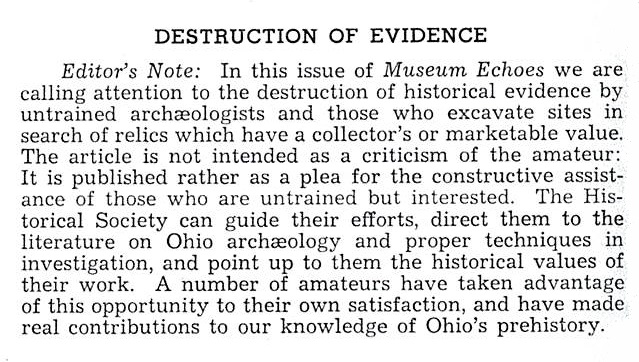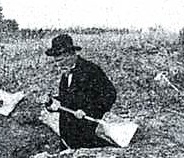
In February of 1953, Thomas Kehoe, Curator of Archaeology for the Museum of the Plains Indian in Browning, Montana, wrote to the
Ohio State Archaeological and Historical Society‘s Curator
Raymond Baby inquiring about “an anti-pot hunting photograph” that had appeared in the Society’s publication
Museum Echoes. He told Baby that “we have the problem of curio-hunters distroying [sic] many of the sites here in Montana” and his museum planned to include a section on preserving Montana’s past in a new exhibit that was being planned. He hoped to get a copy of the image to use in the exhibit.

Image from the October 1946 issue of Museum Echoes showing the man with the shovel. The image has been cropped so that the human remains are not shown.
Baby provided a copy of the photograph to Kehoe. It shows an older man with a white beard. He is wearing a black suit and hat. He is holding a shovel and standing in a large pit with human skeletal remains laid out around him. The published image included no information about the identity of the man or where he was digging. In Baby’s letter to Kehoe he indicated that the only information available for the image was that “the digging took place at or near Sandusky, Erie County, Ohio.” The original article appeared in the October 1946 issue of the Society’s publication
Museum Echoes. It was written by
Richard G. Morgan, then the OHS Curator of Archaeology. Morgan wrote that “each year a number of sites are dug in Ohio by individuals who are untrained in the scientific methods and techniques of excavating. Most of these individuals do not realize that they are destroying evidence which can never be replaced, or they realize it only after the damage has been done. … Some of them seek only the flint spearpoint or the ornaments which they know are sometimes found in mounds or village sites and care nothing for the structural or other features which are often extremely important in identifying the particular culture in question.” Morgan concluded with the acknowledgement that “non-professionals have a contribution to make” and that professionals need and welcome “the cooperation of anyone who is interested in the preservation of the record of the prehistoric Indians.” Morgan pointed out that “collectors and amateur archaeologists” could “assist in the preservation of archaeological records in several ways. They may make surface collections of Indian specimens from specific sites, keeping careful notes of each site and cataloging their specimens. They may also make surveys in an attempt to locate and map all of the sites in their immediate locality And finally they may be of great service in reporting to the Ohio State Archaeological and Historical Society sites that are in danger of destruction.” Sadly, the destruction of Ohio’s ancient heritage described by Morgan continues today. Indeed,
by some accounts the problem has grown even worse than it was in Morgan’s day. According to the
Society for American Archaeology, looting of archaeological sites “threatens the very continuation of archaeology in many areas.” Now more than ever we need the cooperation of everyone interested in Ohio’s ancient and not-so-ancient heritage to help preserve the fragile and rapidly disappearing record of the past. The Society for American Archaeology offers a number of suggestions for how you can help
save the past for the future! Thanks to Sara Nuber Thomas for drawing my attention to the correspondence between Kehoe and Baby! Brad Lepper
 In February of 1953, Thomas Kehoe, Curator of Archaeology for the Museum of the Plains Indian in Browning, Montana, wrote to the Ohio State Archaeological and Historical Society‘s Curator Raymond Baby inquiring about “an anti-pot hunting photograph” that had appeared in the Society’s publication Museum Echoes. He told Baby that “we have the problem of curio-hunters distroying [sic] many of the sites here in Montana” and his museum planned to include a section on preserving Montana’s past in a new exhibit that was being planned. He hoped to get a copy of the image to use in the exhibit.
In February of 1953, Thomas Kehoe, Curator of Archaeology for the Museum of the Plains Indian in Browning, Montana, wrote to the Ohio State Archaeological and Historical Society‘s Curator Raymond Baby inquiring about “an anti-pot hunting photograph” that had appeared in the Society’s publication Museum Echoes. He told Baby that “we have the problem of curio-hunters distroying [sic] many of the sites here in Montana” and his museum planned to include a section on preserving Montana’s past in a new exhibit that was being planned. He hoped to get a copy of the image to use in the exhibit. 